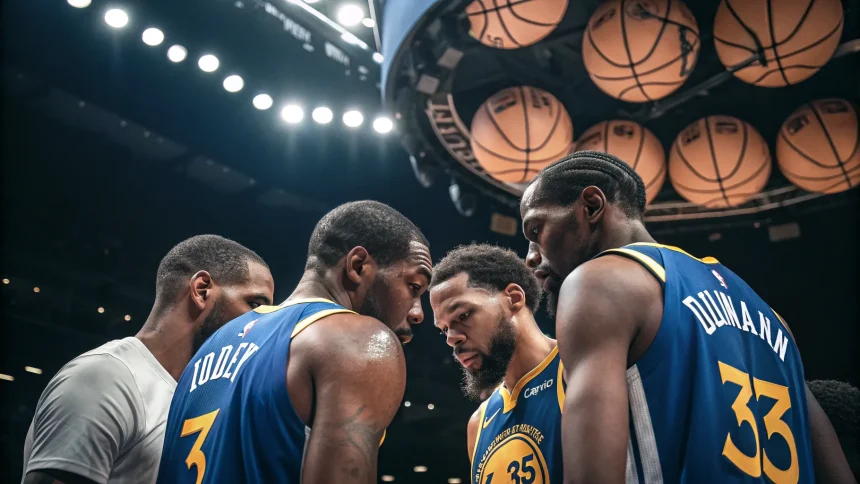A simple idea is gaining steam around front offices and player camps. If top NBA players accept less than the maximum salary, superteams might survive the heavy rules of the new labor deal. The question now is whether stars will trade dollars for depth as the league’s cap rules tighten.
The debate flared as Kevin Durant’s contract history and Jalen Brunson’s recent extension drew attention. Both deals came in under the top figures they could have demanded. Some executives see a template. Others doubt it can scale in a league where stars have earned their leverage.
The squeeze of the second apron
The 2023 collective bargaining agreement added new hurdles for high-spending teams. The “second apron” now acts like a hard ceiling with sharp limits on team building. For 2024–25, that line sits near $189.5 million in team salary.
Teams above it face strict rules that make adding help tough. The goal is to push parity and discourage mega-payrolls with three or more max-level players.
- No access to the taxpayer mid-level exception.
- Trade restrictions, including limits on aggregating salaries.
- Frozen future first-round picks that can drop to the end of the first round.
- Ban on cash in trades and limits on buyout signings.
These limits hit depth first. They also reduce in-season fixes. Big Threes that once patched holes with buyouts and mid-level signings must now find low-cost role players or draft hits.
Why smaller star deals matter
Durant took less in Golden State to keep the roster strong. That choice helped fund supporting pieces around Stephen Curry and Klay Thompson during title runs. Jalen Brunson’s 2024 extension with New York came in below his top allowed number. His camp signaled a team-first plan to preserve room for help.
“If more stars take after Kevin Durant and Jalen Brunson by accepting well below their max salaries, it could be the cure to the demise of Big Threes around the NBA.”
Even a few million in savings can restore a key exception or open a trade path. One cap strategist said a 5% haircut from two stars could be the difference between a minimum-only summer and one solid rotation piece.
Lessons from past superteams
The Heat’s trio of LeBron James, Dwyane Wade, and Chris Bosh accepted smaller deals in 2010. Those moves allowed Miami to stock veteran shooters and defenders. The result was four Finals trips and two titles.
The Warriors kept a title core by threading similar needles during their run. On the other hand, recent groups loaded with max money have felt the crunch. The Suns wrestled with depth and trade limits. The Clippers faced a top-heavy cap with little mid-tier flexibility. Brooklyn’s past experiment collapsed under injuries and limited roster tools.
The counterargument: market power and fairness
Players win max deals because they drive wins and revenue. Many around the league argue stars should not carry the cost of cap design. Risk also factors in. Contracts protect against injuries and aging. Taking less can be costly if a player’s next deal never comes.
Union leaders have long warned against social pressure to “take a discount.” They note that owners and the league set the rules. They also point out that cap growth and media money justify full-value contracts.
What a workable model might look like
Executives describe a middle path for teams with two elite players who want a third high-end piece. It is not always about deep cuts. It is about planned structure and timing.
- Slight discounts with player options to keep leverage.
- Descending year-by-year salaries to free space later.
- Incentives for games played and playoff results.
- Staggered extensions to avoid multiple peak salaries in one season.
Agents say that clear recruiting helps. If a star sees a defined target, like a defensive anchor or elite shooter, a modest cut is easier to sell. Without a plan, discounts lose appeal fast.
What comes next
Cap experts expect more teams to avoid the second apron, not chase it. Two-star builds with strong role players may become the norm. Boston’s recent approach with two main stars and a deep group is the model many cite.
Still, if a few headliners copy Durant and Brunson, the league could see selective Big Threes return. It will depend on trust, timing, and a clear path to contention. Front offices will keep pitching the math. Stars will weigh legacy against dollars.
For now, the new rules are winning. The second apron punishes big payrolls and rewards balance. Discounts can bend the math, but only when paired with smart planning and a roster that justifies the sacrifice. Watch the next wave of extensions. That is where choices will signal the future of superteams.







